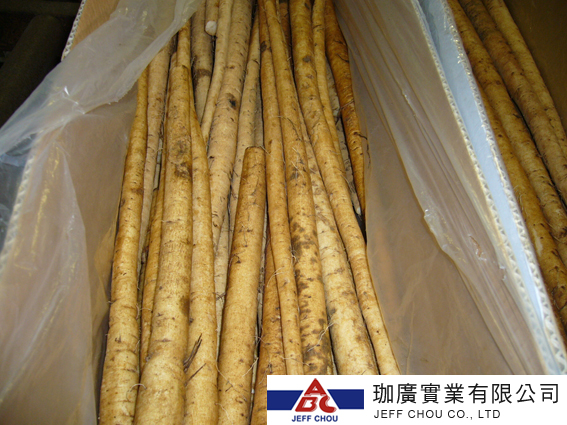The taproot of young burdock plants can be harvested and eaten as a root vegetable. While generally out of favour in modern European cuisine, it remains popular in Asia. Arctium lappa is called (牛蒡), pronounced "gobō" (ごぼう) in Japanese or "niúbàng" in Chinese, in Korea burdock root is called "u-eong" (우엉) and sold as "tong u-eong" (통우엉), or "whole burdock". Plants are cultivated for their slender roots, which can grow about one metre long and two centimetres across. Burdock root is very crisp and has a sweet, mild, and pungent flavour with a little muddy harshness that can be reduced by soaking julienned or shredded roots in water for five to ten minutes.
Immature flower stalks may also be harvested in late spring, before flowers appear; their taste resembles that of artichoke, to which the burdock is related. The stalks are thoroughly peeled, and either eaten raw, or boiled in salt water. Leaves are also eaten in spring in Japan when a plant is young and leaves are soft. Some A. lappa cultivars are specialized for this purpose. A popular Japanese dish is kinpira gobō (金平牛蒡), julienned or shredded burdock root and carrot, braised with soy sauce, sugar, mirin and/or sake, and sesame oil. Another is burdock makizushi (sushi filled with pickled burdock root; the burdock root is often artificially coloured orange to resemble a carrot).
In the second half of the 20th century, burdock achieved international recognition for its culinary use due to the increasing popularity of the macrobiotic diet, which advocates its consumption. It contains a fair amount of dietary fiber (GDF, 6g per 100g), calcium, potassium, amino acids, and is low in calories. It contains a polyphenol oxidase, which causes its darkened surface and muddy harshness by forming tannin-iron complexes. Burdock root's harshness harmonizes well with pork in miso soup (tonjiru) and with Japanese-style pilaf (takikomi gohan).(quote from wikipedia)












